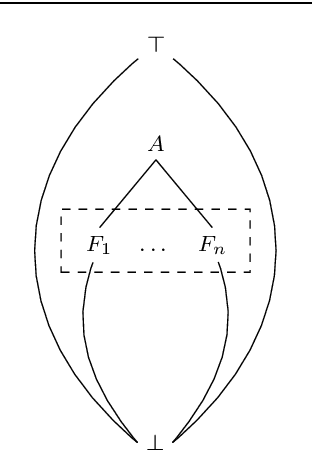Victor Dalmau
Conjunctive Queries: Unique Characterizations and Exact Learnability
Aug 16, 2020



Abstract:We answer the question which conjunctive queries are uniquely characterized by polynomially many positive and negative examples, and how to construct such examples efficiently. As a consequence, we obtain a new efficient exact learning algorithm for a class of conjunctive queries. At the core of our contributions lie two new polynomial-time algorithms for constructing frontiers in the homomorphism lattice of finite structures. We also discuss implications for the unique characterizability and learnability of schema mappings and of description logic concepts.
The Limits of Efficiency for Open- and Closed-World Query Evaluation Under Guarded TGDs
Dec 28, 2019Abstract:Ontology-mediated querying and querying in the presence of constraints are two key database problems where tuple-generating dependencies (TGDs) play a central role. In ontology-mediated querying, TGDs can formalize the ontology and thus derive additional facts from the given data, while in querying in the presence of constraints, they restrict the set of admissible databases. In this work, we study the limits of efficient query evaluation in the context of the above two problems, focussing on guarded and frontier-guarded TGDs and on UCQs as the actual queries. We show that a class of ontology-mediated queries (OMQs) based on guarded TGDs can be evaluated in FPT iff the OMQs in the class are equivalent to OMQs in which the actual query has bounded treewidth, up to some reasonable assumptions. For querying in the presence of constraints, we consider classes of constraint-query specifications (CQSs) that bundle a set of constraints with an actual query. We show a dichotomy result for CQSs based on guarded TGDs that parallels the one for OMQs except that, additionally, FPT coincides with PTime combined complexity. The proof is based on a novel connection between OMQ and CQS evaluation. Using a direct proof, we also show a similar dichotomy result, again up to some reasonable assumptions, for CQSs based on frontier-guarded TGDs with a bounded number of atoms in TGD heads. Our results on CQSs can be viewed as extensions of Grohe's well-known characterization of the tractable classes of CQs (without constraints). Like Grohe's characterization, all the above results assume that the arity of relation symbols is bounded by a constant. We also study the associated meta problems, i.e., whether a given OMQ or CQS is equivalent to one in which the actual query has bounded treewidth.
Conjunctions of Among Constraints
Jun 15, 2017

Abstract:Many existing global constraints can be encoded as a conjunction of among constraints. An among constraint holds if the number of the variables in its scope whose value belongs to a prespecified set, which we call its range, is within some given bounds. It is known that domain filtering algorithms can benefit from reasoning about the interaction of among constraints so that values can be filtered out taking into consideration several among constraints simultaneously. The present pa- per embarks into a systematic investigation on the circumstances under which it is possible to obtain efficient and complete domain filtering algorithms for conjunctions of among constraints. We start by observing that restrictions on both the scope and the range of the among constraints are necessary to obtain meaningful results. Then, we derive a domain flow-based filtering algorithm and present several applications. In particular, it is shown that the algorithm unifies and generalizes several previous existing results.
Arc Consistency and Friends
Apr 26, 2011Abstract:A natural and established way to restrict the constraint satisfaction problem is to fix the relations that can be used to pose constraints; such a family of relations is called a constraint language. In this article, we study arc consistency, a heavily investigated inference method, and three extensions thereof from the perspective of constraint languages. We conduct a comparison of the studied methods on the basis of which constraint languages they solve, and we present new polynomial-time tractability results for singleton arc consistency, the most powerful method studied.
Beyond Hypertree Width: Decomposition Methods Without Decompositions
May 12, 2005Abstract:The general intractability of the constraint satisfaction problem has motivated the study of restrictions on this problem that permit polynomial-time solvability. One major line of work has focused on structural restrictions, which arise from restricting the interaction among constraint scopes. In this paper, we engage in a mathematical investigation of generalized hypertree width, a structural measure that has up to recently eluded study. We obtain a number of computational results, including a simple proof of the tractability of CSP instances having bounded generalized hypertree width.
 Add to Chrome
Add to Chrome Add to Firefox
Add to Firefox Add to Edge
Add to Edge